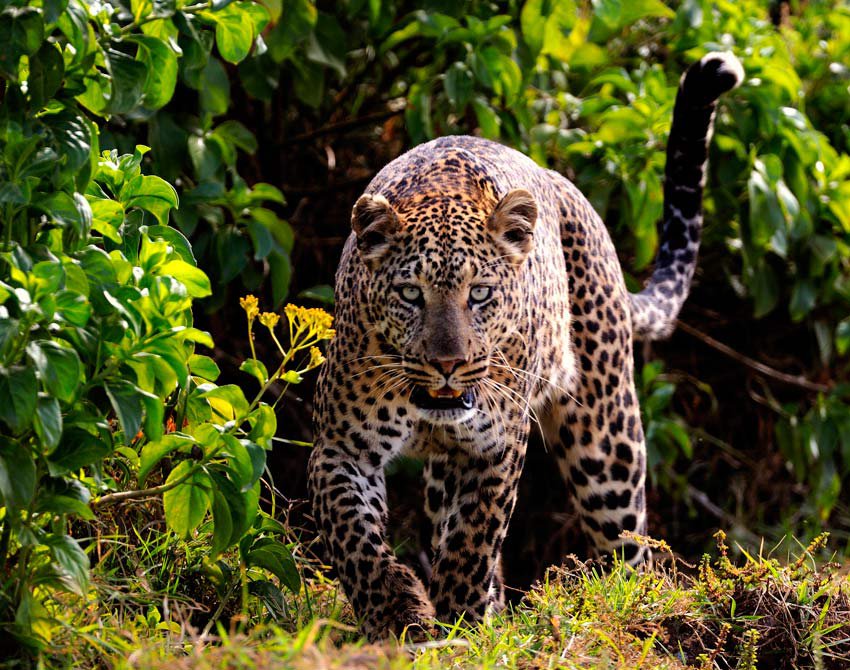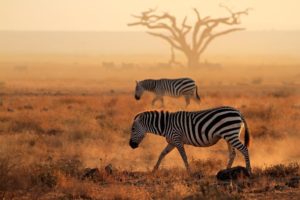Tsavo West National Park
Although Tsavo West and Tsavo East were once a single mega-park, they were separated decades ago, along a line coinciding with the Mombasa highway – and they feel like quite distinct national parks with different eco-systems: the open, flat-to-undulating plains and scattered bush of Tsavo East National Park and the much more wooded, hilly landscapes, dotted with volcanic cones and dramatic, black lava flows, that characterise Tsavo West National Park.
Just as Tsavo East has its core area in the far south, so Tsavo West safaris invariably concentrate on a core part of the park, in the north, known as the Developed Area – a relatively small, 1,000km² area north of the Tsavo River, with magnificent landscapes and a good network of sand and gravel park roads. This district’s well-watered, volcanic soil supports a good range of woodland and savannah habitats for the full panoply of Kenyan wildlife .
To the south of Tsavo West, the Lumo Community Wildlife Sanctuary, directly bordering the well-known Taita Hills Game Sanctuary, is one of Kenya’s most successful new community conservation initiatives. If you’re interested in Lumo safaris you’ll find there’s just one lodge on the conservancy and that it shares a common border with the Taita Hills Sanctuary.
Geography and wildlife of Tsavo West
The northern part of Tsavo West is fascinating geologically: the whole developed area is dotted with old and new volcanic hills, ranging from pimples to great pyramids on the plain. The district was ravaged as recently as 200 to 300 years ago by a series of violent volcanic . West of Chyulu Gate, en route to Amboseli National Park, the road passes for several kilometres across a huge expanse of black lava rock, still barely colonised by plant life. And north of this area, a dramatic route climbs into the Chyulu Hills, out of Tsavo West National Park altogether and into the neighbouring Chyulu Hills National Park
Tsavo West landmarks
The most iconic attraction in the park is Mzima Springs. The crystal-clear water of this chain of lakes is filtered through the volcanic rocks of the Chyulu Hills just to the north. Shaded by majestic fig and acacia trees, the lakes swarm with fish, large crocodiles and some big pods of hippos. You can leave your vehicle and follow a pretty nature trail – though you need to keep an eye out for large animals, especially early in the morning or before dusk. If you’re lucky, the underwater viewing chamber, accessed by a pier, can provide unique photo opportunities – of a sinuous, gliding crocodile, or the delicate, tiptoe, swimming-walking style of a hippo.
The Shetani Lava Flow is the largest of a whole series of lava flows in the park, with several places where you can get out of your vehicle and stretch your legs, including a series of lava caves below the surface. These caves used to be notorious for trapping prey animals that had stumbled inside in search of water, and then trapping predators that had followed them. At one time there was even a series of plaques identifying the bones on the cave floor. The Shetani Lava Flow is named after the Swahili for devil or malevolent ghost.
The wildlife of Tsavo West National Park
The hilly landscapes and woodland of Tsavo West mean that spotting wildlife can sometimes be tricky. There’s plenty of it, however, including large numbers of elephants and good lion prides. There’s also a good chance of seeing black rhinos in the secure rhino sanctuary. The experience of being on safari in Tsavo West is very different from a safari in Tsavo East or a Maasai Mara safari, where you often have views across wide-open country. Tsavo West safaris are more about unexpected sights as you turn a bend on a wooded track. Giraffe, impala, buffalo and Burchell’s zebra are all common species here.
The birdlife in the park is outstanding – if you’re on a birdwatching safari you’ll be knocked out by the number of sightings you have. The white-headed buffalo weaver is a particularly noticeable species, with its prominent bright red rump, and there are at least eight recorded hornbill species here. If you have time for an all-day game drive to the southwest corner of the park, you could visit Lake Jipe, which is a real waterbird paradise.
Maneaters of Tsavo
Tsavo’s lions achieved notoriety in 1898 during the building of the Mombasa-Nairobi railway. Building the iron bridge across the river (next to the highway between Tsavo East National Park and Tsavo West National Park) slowed the construction teams down for several months – the comparatively shallow but rocky ravine was a major obstacle – and two male lions began to snatch labourers from their tents at night. It took nine months for Colonel JH Patterson, in charge of the bridge-building, to kill the lions, by which time more than thirty labourers had been killed by them, and the remainder had fled the railhead. Today, the two maneaters (maneless, as is the norm in the region) can be seen in the Chicago Field Museum. The story still adds an extra frisson to lion sightings in either Tsavo West or Tsavo East.
History of Tsavo West
Until the time of the railway, the Tsavo West region had been inhabited for thousands of years by hunter-gatherers, with limited numbers of Kamba people moving through the region in the last thousand years or so, herding their livestock or looking for honey. Maasai cattle herders arrived in the eighteenth century from the Rift Valley further north, but the tsetse flies of the woodland that infected their herds with sleeping sickness put them off from spending long here: despite Tsavo West’s good water, the drier plains of Tsavo East were a safer grazing area. The Tsavo West region became a national park in 1948 and safaris in Tsavo West became popular in the late 1960s when the first charter flights began arriving in Mombasa, and really took off when the Mombasa-Nairobi road was first surfaced in 1969.
Lumo Sanctuary
The 500km² of Lumo Community Wildlife Sanctuary (LUMO is an association of the Lualenyi, Mramba and Ossa ranches whose communities have come together to promote wildlife tourism) is one of Kenya’s most successful new community conservation initiatives. Lumo shares an open boundary with the much smaller Taita Hills Sanctuary. Both sanctuaries usually have plenty of elephants, and you’ll see many other species of plains game, including buffalo, giraffe and several species of antelope and gazelle. Predators can be rather more elusive, but the night drives here are always fun (look out for unusual sightings such as melanistic servals and aardwolves), and the birdlife, with 400-plus species, is terrific.




